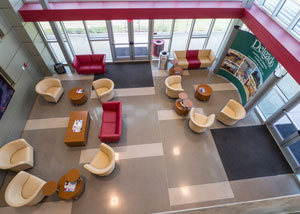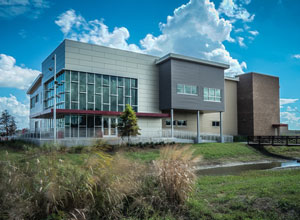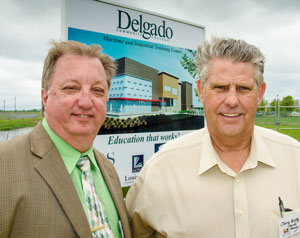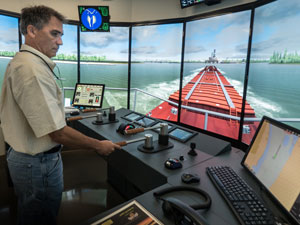Hurricane Katrina, the banshee that visited floodwaters upon the Gulf Coast in 2005, created an endless list of rebuilding and recovery projects. Among them was Delgado Community College abutting City Park in New Orleans, specifically the Maritime and Industrial Training Center. Delgado was the first community college in the United States to incorporate a bridge training simulator.
Following Katrina, the remnants of the City Park marine training facility, including the original Transas simulator, were trucked to a cluster of trailers at the college’s New Orleans East location, adjacent to its existing maritime and industrial fire training facility between Old Gentilly Road and the Gulf Intracoastal Waterway.
On April 1 last year, Delgado opened a new $7 million, 18,750-square-foot building to house the Maritime and Industrial Training Center. “We’ve been planning this for 12 years since the facility at City Park was flooded,” said Rick Schwab, senior director of the center. “FEMA money helped build the new facility.”
The project was approved in 2007 by Gov. Kathleen Blanco, who was enduring the political effects of shepherding Louisiana through Katrina. It was tight, but Delgado won the funding race just before the collapse of the oil economy. “We’ve dedicated the facility to the marine, petrochemical and oil and gas industries,” Schwab said.
Three new Transas interconnected full-mission bridge simulators have replaced the older bridge system. Keith Roulette, senior technical applications representative from Transas, set up the simulators and trains the instructors, who in turn train the pilots. “The best aspects of the system are its flexibility and its capability to recreate real-life scenarios that a pilot may only encounter once in his life,” Roulette said. “But that one time matters.”
“Our inland simulator is geared for both conventional and z-drive propulsion and can be set up for different vessels to be running at the same time,” Schwab said.
Capt. Jerry Wiltz is senior port captain with Florida Marine Transporters (FMT) and is a general board member with the Maritime and Industrial Training Center. Wiltz said the new simulators allow steersmen to be trained on up to 6,000-hp tows of two and three tank barges and bulk tows of 25 to 30 barges. The wheelmen also can work on two simulators that interact with one another, making it possible for one simulated tow to pass or overtake the other.
 |
|
The $7 million, 18,750-square-foot Maritime and Industrial Training Center is built to give mariners access to the latest technology in a comfortable environment. |
“The simulators are very helpful in that each one of the new and upcoming wheelmen will go through the course prior to being accepted into the Florida Marine pilothouse training program,” Wiltz said. “The Morgan City stretch of the Atchafalaya (River) is the most crucial part of the simulator training.”
FMT engages its senior captains to mentor the younger trainees before they run through steersman training on the simulators. “I’ve gone there a couple of times to give the new recruits some pointers and explain the Morgan City bridges before they get on the simulators,” said Capt. Kirby Dupuis.
With 48 years of experience running the Morgan City stretch of the Atchafalaya without incident, Dupuis is well qualified to pass on pointers to prospective pilots. “I’ve run the bridges with all kinds of tows and I’ve never hit them,” he said.
Dupuis abides by a very clear set of checks and procedures on what is considered one of the most demanding stretches of river in the country to navigate a tow. On an early morning in November, the captain displayed his skills aboard the 90-foot, 2,600-hp FMT towboat Capt. Jerry J. Wiltz. The boat was headed south on the Atchafalaya, coming from Krotz Springs, La., with two empty tank barges destined for the Sun Oil Terminal at Beaumont, Texas.
Dupuis took time to describe his way of making the Morgan City bridges. Just above the city, southbound out of Stouts Pass, Swiftships shipyard was on the port side of the tow as it entered Berwick Bay. Next was the Conrad Industries shipyard at Conrad Point, left bank descending, on the Morgan City side of the river.
After making the turn around Conrad Point, Dupuis checked the tow’s direction by looking back at the Berwick Lock where Bayou Teche enters the Atchafalaya River.
“If the stern is even with the lock, you’re OK. If the stern is sliding to starboard, then you have to come ahead a little to outrun the slide,” he said.
 |
|
It is also built to stand up to the elements, with hurricane-proof windows and waterproof exterior tiling. |
With the tow moving slowly ahead, Dupuis contacted VTS Berwick Bay, commonly known as Berwick Traffic. The facility, with direct control of vessels transiting two highway bridges and a railway bridge, is located at the Coast Guard Marine Safety Office in Morgan City. Owing to the strong currents, the VTS center maintains one-way traffic through the bridges. During high water and the resulting stronger currents, a tug with low horsepower relative to the length and width of its tow is required to hire an assist tug while transiting the spans.
Running southbound, first up is the Highway 182 bridge, then the Highway 90 bridge followed by the railway bridge, each a few hundred yards apart. “If you have a long tow, the head will be at the railway bridge before you’ve cleared the 90 bridge,” Dupuis said.
With the bridges on the stern it’s smooth sailing, followed by a right turn to enter the Gulf Intracoastal Waterway toward Beaumont.
Dupuis said the simulators are a great way to learn about this difficult stretch of the river, allowing trainees to garner knowledge and experience usually obtained only by making mistakes. “They can’t do any damage on the simulator,” he said.
The equipment is also employed to configure custom programs for VTS utilizing the XVR, a virtual-reality instant command system that recreates scenarios for oil spills, bridge collisions and the like for any location. “It takes the place of tabletop exercises for crisis management,” Schwab said. “The software models can duplicate real-life situations.”
An additional benefit of the simulators is the ability to create an analytical model prior to building a structure that will jut into the channel — for example, a scenario that anticipates the effects on navigation once a new pier is completed.
Delgado offers a full range of marine training that includes maritime and industrial firefighting, radar, safety and Coast Guard-approved instruction, including full-mission bridge simulator courses and gap-closing courses for STCW endorsements.
 |
|
Rick Schwab, left, senior director of Delgado’s Maritime and Industrial Training Center, joins Capt. Jerry Wiltz of Florida Marine Transporters at the groundbreaking in 2015. |
“We’re partnering with corporations up and down the river,” Schwab said. “The building is built for corporate training for all industries.” Courses are offered from one to 20 days, allowing mariners to coordinate their training with their shore time.
In addition to FMT, Delgado is training employees from river towing companies such as Enterprise Marine, Settoon Towing, LeBeouf Bros., Turn Services and Marquette Transportation. On the industrial side, the client list includes Exxon, Shell, BP and inland petrochemical and drilling companies. There are cross-training programs for people moving from oil and gas to petrochemical employment and international oil and gas to domestic oil and gas.
The new facility sparkles in modern materials, finishing treatments and furniture. Schwab is not reticent to point out that it contains all of the amenities for a first-class training experience in a pleasing environment. “We want them to feel comfortable and feel at ease and feel at home,” he said. “We were in trailers for 21 years with cramped common areas. And we built the facility for growth.”
Spawned by Katrina and built with a repeat performance in mind, the building is “as hurricane-proof as can be,” Schwab said. Designed by Sizeler Thompson Brown Architects and constructed by The Lemoine Co., both of New Orleans, the facility has hurricane-proof windows, waterproof exterior tiling, a high footprint and a backup generator to guard against any interruption of training due to power outages.
“We have people training here from all over the world and we don’t want them to waste training time due to shutdowns,” Schwab said.

